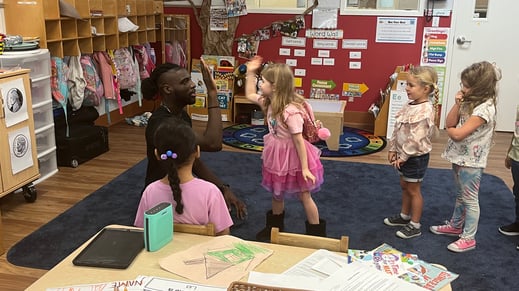
As you know, CLASS® is a tool that captures educator-child interactions. When it comes to the dimension of Concept Development, the focus is on the method the educator uses to provide instruction in the classroom. While the interactions are what get measured with CLASS, as an educator, you can plan for Concept Development to be more intentionally woven throughout your lessons.
Let’s look closer at how to do this.
Planning with Concept Development In Mind
When planning for Concept Development, it's helpful to list the indicators of the dimension on a supplemental lesson plan sheet. You can find these indicators in your Dimensions Guide.
Create one plan for each interest area currently present in your classroom, as well as one for each major component of your day, such as small groups, whole groups, snacks, and meals.
For instance, I may have a small group planned called “Comparing Size.” My materials for the activity are three picture cards—one is a small tennis ball, one is a soccer ball, and the last is a beach ball. The guidance provided in my curriculum book may say something like this:
- Display pictures of the balls. Ask which is the biggest and which is the smallest.
- Next, place the cards in order by size. Point to them and label them small, medium, and large.
- Then, have children compare the sizes of other sets of three objects.
There are some hints of comparison here, but we can take this same activity and brainstorm ways to make it go a little deeper in Concept Development:
Activity: “Comparing Sizes” |
|
Indicator |
What to Say |
|
Analysis and Reasoning Think: What thought-provoking and open-ended questions can I ask instead of questions more rote in nature? |
|
|
Creating Think: How can I get the children to brainstorm and come up with their own ideas? |
|
|
Integration Think: What else have we done recently in the classroom that relates to this activity? |
|
|
Connections to the Real World Think: Can I connect this activity to something in their lives outside the classroom? |
|
This lesson-planning strategy is just a first step, of course. The most important part is engaging the students in the activity using your strategies on the lesson-planning sheet.
Hopefully, you will find this small example of a structure that supports the process is helpful. Remember, Concept Development is not something you are either “good at” or “bad at,” but a learning process for grown-ups too. Improving takes planning and practice.
If you try this strategy out, you may discover it gets easier to analyze the planned activities and embed more Concept Development into them over time.

